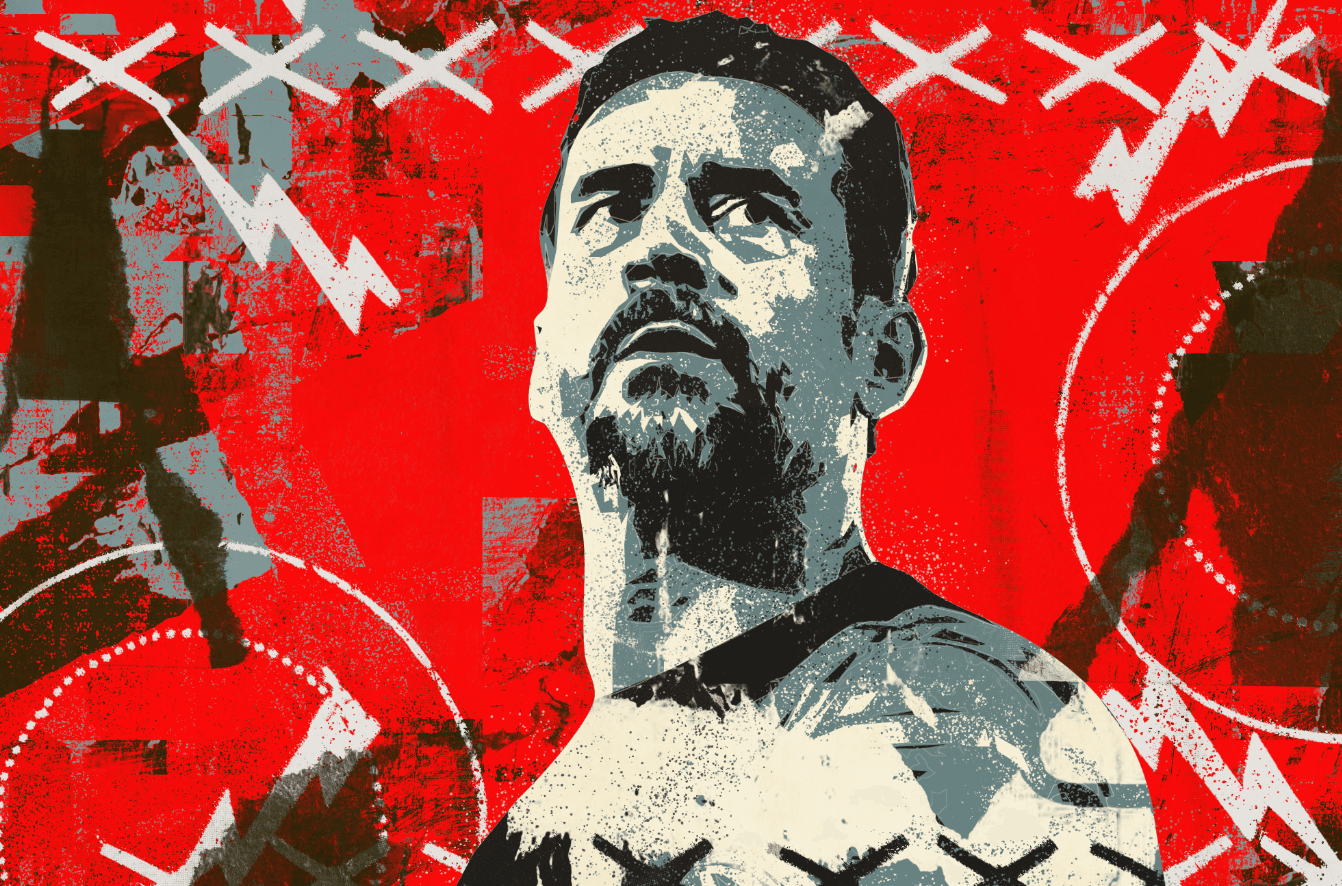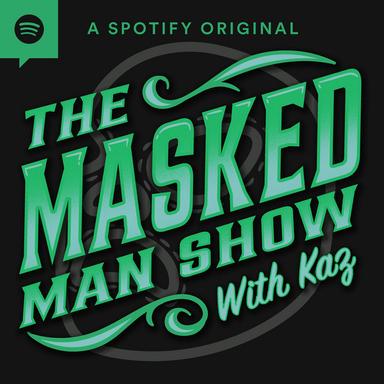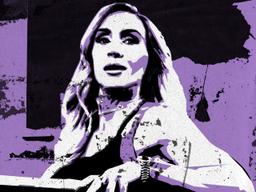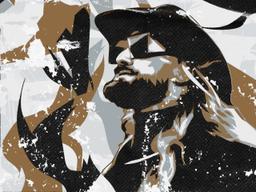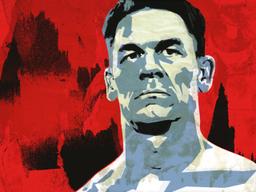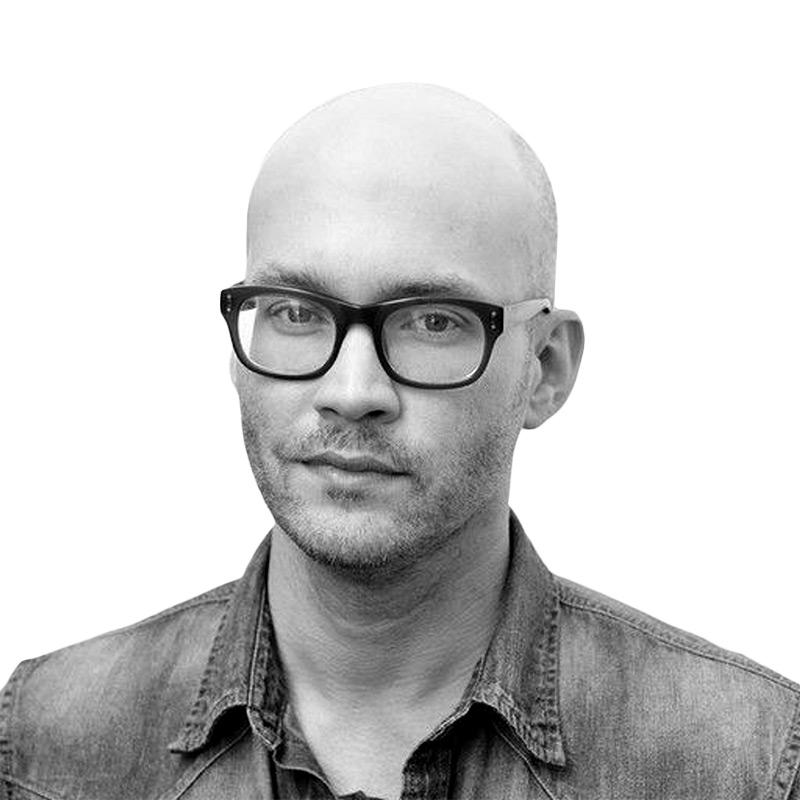WWE SmackDown, March 28, 2025. CM Punk enters the ring for a contract signing for his upcoming WrestleMania match alongside his opponents, Roman Reigns and Seth Rollins, as well as Paul Heyman, Reigns’s “advocate” and a longtime friend (and former manager) of Punk. The crowd is chanting Punk’s name, and Punk declares, “I have come here to chew bubble gum and sign a contract, and I’m all out of bubble gum”—an unsubtle reference to “Rowdy” Roddy Piper, one of Punk’s pro wrestling inspirations. Punk sits down to sign the contract. Heyman leans in to help.
“I know what you’re looking for, and it’s in there. You’re closing the show at WrestleMania.” Here, Heyman’s voice starts to break. “You get to live your dream of all dreams. CM Punk, you are a WrestleMania main eventer.”
Punk grasps the contract in his hands and his eyes start to well up. It felt so honest, so real, like he was finding out that fact in real time. Maybe he was, or maybe he was just coming to grips with it in that moment. Or maybe he was acting—with Punk, the line is always hazy, and that’s what makes him so great. But the tears felt significant, even if they’re not exactly a new thing.
Watch his debut for AEW in 2021 after seven years away from the ring, and you’ll see CM Punk at his most human. The look of real emotion on his face is one of trepidation, then gratitude seated in an inherent sadness. CM Punk is an actor who has mastered the furrowed brow and gritted teeth of the pro wrestling form. But he’s also a truth-teller, a tangible human, and in emotional moments you can see the honesty break through: it’s a melancholy, a wistfulness.
Punk’s match at WrestleMania this year has revolved around the mutual loathing between the three stars involved (of course), but also around a mysterious favor that Heyman owed Punk. That favor was not to main-event WrestleMania, but rather, it later came to light, for Punk to have Heyman in his corner—instead of Reigns’s—for the match. On its face, it’s a rather ethereal desire, to value camaraderie over ego. It’s somewhat impractical, considering the kind of favor Punk could have extracted. But being at the center of the storyline has meant that the weeks and months of buildup to this match have been crafted around an odd question: What does CM Punk want?
When CM Punk peaked during his first run in WWE—a dire, innervating run that started in earnest with his infamous “pipe bomb” promo in 2011 and ended with him walking out on the company in 2014—he was known as the “Voice of the Voiceless,” the only wrestler speaking for the legions of disaffected pro wrestling fans that felt alienated by the monotony (and monopoly) of WWE. He was naturally suited for the role—unlike so many wrestlers that sidestepped into the wrestling world after careers as tight ends or bar bouncers, he grew up a wrestling fan and wrestled his first matches in a backyard federation that he put on with some friends, and on top of that he was a few pounds of muscle lighter than the WWE archetype, all of which made him seem like “one of us” to the fans in the stands. But moreover, he was a natural. Unlike many of the tattooed backyard progeny that preceded him, Punk was an old soul, a very good wrestler, and, most importantly, the best talker the business had seen since the heydays of Ric Flair and Piper. Unlike his forebears, though, Punk didn’t scream, or snarl, or punctuate his sentences with high-pitched flourishes. He barely raised his voice. He could sell insubordination—when he used someone’s real name, or referred to an off-screen subject, it never felt scripted or forced. Just like the best wrestlers can make receiving a fake punch look real, Punk could make you believe that everything he did, even if it was on camera in the middle of the ring, was an act of rebellion. And in the age of a broken product, he mostly just told the truth, and it was galvanizing.
What CM Punk wanted back then was a better version of pro wrestling. Some of this was ephemeral, like when he rallied for the return of WWF ice cream bars, a metaphor for a bygone era that was better, sure, but mostly because we were kids when we were watching it. Punk spoke to the adults in the audience, or at least the repressed 30-somethings who could remember childhood but could not abide being insulted by overly simplistic storytelling. That goes to the more concrete part of Punk’s dream—he demanded a reverence for the sport, for the kind of high-level ring work that existed in New Japan and Ring of Honor, for the urgency and bloodlust of ECW and the Southern territories in the ’70s and ’80s. In a milieu that was increasingly cartoonish and annoyingly self-aware, Punk wanted to elevate the art of pro wrestling.
Punk turned that self-awareness on its head, speaking directly to the backstage powers and the fans sitting at home simultaneously. We all know what we’re doing here, he seemed to say, so why don’t we try to do better? After he left WWE, it has to be noted, Punk’s star in pro wrestling somehow grew. Every dull moment at WWE’s biggest shows garnered “CM Punk” chants. (As Punk himself said during the contract signing, the fans “stood by me and chanted my name for 10 long years.”) If before he was the harbinger of a movement for change in WWE, in his absence he had become its messiah.
Punk spent seven years in retirement before reemerging in AEW, and his debut there had the emotional impact of the Second Coming. It was the week of SummerSlam, WWE’s second-biggest event of the year, and Punk had singlehandedly upstaged it. AEW was in many ways the antithesis of modern WWE and thus the culmination of Punk’s quest. He was a star for the company until a series of behind-the-scenes issues—highlighted by two backstage fights—set the stage for his departure. The rap on Punk at this point was clear: he was a bankable star, but maybe too disagreeable to bank on. Punk’s general disillusionment with AEW, though multifaceted, hinged on the fact that AEW wasn’t a “real business.” Idealistic, sure. In line with Punk’s vision for pro wrestling, OK. But, in Punk’s mind at least, it was not a sustainable business model. Not, well, bankable. If you were to draw a line from the Punk pro wrestling argument of 2014 to that of 2023, you see a maturation of the ideology. No longer is it that pro wrestling is great, but that pro wrestling could and should be a great business.
When he left AEW in 2023, there was immediate talk that he would land in WWE, but there was reasonable consternation about how he would fit into the locker room, and maybe more importantly how he’d gel with the front office, which was now helmed by Paul “Triple H” Levesque, Punk’s former on-screen and (reported) real-life antagonist. At Survivor Series: WarGames 2023, at the end of the show, “Cult of Personality” hit, the crowd went wild, and he returned to WWE a decade after leaving it. As he emerged from the tunnel for the biggest moment of his career, there was a wistfulness in his eyes.
"Once upon a time, an 'American Dream' taught me that if you speak from the heart, you cannot go wrong because it is the truth and this is the truth: I'm home," Punk said on the following episode of Raw. No longer inherently rebellious, Punk seemed to embrace his place in the WWE firmament. "The voiceless found their voice and I couldn't be more proud of you," said Punk to the fans. "I love you guys."
It was almost as if he needed the AEW foray to justify his return; coming straight back to WWE would have seemed like an abdication of his earlier crusade and all the reasons he gave for leaving. But after going through AEW, competing with WWE, and rediscovering his love for wrestling, the narrative had an arc. Punk emerged from his time in the wilderness a triumphant, if more mature, figure. If before he would see the cheers of the crowd as a cudgel—see, I’m right and you’re wrong—now he was willing to hear them and just say “Thank you.”
Probably the most amazing part of Punk’s reintegration into WWE is how seamlessly he has fit in. (This is excluding, of course, the hurt feelings of Seth Rollins and some others who were offended by Punk’s exit and seeming disregard for the company.) He does the media rounds gamely, even wearing suits when the situation calls for it. He lets the camera crews tail him backstage. He did Stephanie McMahon’s new series, Stephanie’s Places, and made public peace with Levesque, her husband. He holds babies. He wears Jey Uso sunglasses. He’s regularly a mensch with his compatriots, staying at ringside to get a front-row view of Cody Rhodes’s entrance at one show, and bringing a young kid in a Rhodes costume into the ring afterward. Roddy Piper got stabbed by fans, he never hugged kids! one wants to think, except, well, of course he did. The successful rebel always becomes the establishment. It’s the failed ones that sit at home grousing on shoot interviews.
Punk changed the wrestling world. He’s synonymous with the sport. He inspired a generation of kids to become wrestlers. (He’s also spent significant time since his return at WWE’s Performance Center in Florida, coaching a new crop of kids that probably had “pipe bomb” pajamas.) He’s accomplished almost everything there is to accomplish in the business, short of a WrestleMania main event, which he’ll get in just over a week. No corporate force standing in Punk’s way; the president of WWE called Punk directly to negotiate his return. So is the crusade over? What does CM Punk want? Or rather, what’s left to want?
The past few months have been a journey into the soul of CM Punk. At Survivor Series last November, he joined Reigns’s Original Bloodline team to take on Bloodline 2.0, helmed by upstart Solo Sikoa. Punk had no stake in the feud other than his friendship with Reigns’s advisor Heyman, so Punk exacted the mysterious favor from Heyman in return for the temporary alliance. He feuded with Rollins through the New Year, including their main event on the debut episode of Raw on Netflix. (If there was any doubt that Punk was WWE establishment, that was put to bed on the Netflix red carpet.) At the Royal Rumble, his quest to win the Rumble match and challenge for a world title at WrestleMania was dashed due to conflict with Rollins and Reigns, and the course was charted for the three to have their match at WrestleMania. Punk and Rollins fought again in a cage on Raw on March 10 at Madison Square Garden, only to have the match interrupted by Reigns attacking Rollins. When Reigns turned around, though, he saw Heyman tending to a wounded Punk, and the emotional stakes were set: Reigns and Punk both hate Rollins, and they don’t like each other, but they really hate that Heyman is close to the other guy.
It’s almost a part of the match itself: There might not be a world title belt on the line, but the winner of this match gets to be Heyman’s favorite. Punk’s favor, after all, is to have Heyman in his corner. But why? To play mind games with Reigns? Maybe, but that seems better served for a one-on-one match or a championship contest, doesn’t it? According to Punk, it's a matter of loyalty. Heyman refused to fire Punk when Punk was coming up through WWE’s developmental system and some company higher-ups were not impressed by him. They remained close through Punk’s debut on the main roster as part of the rebooted ECW brand, a company Heyman had run prior to coming to WWE. When Heyman was fired by WWE (he was, of course, later brought back), they commiserated after the show. “I mistakenly made it about me,” Punk recalled on the April 4 episode of SmackDown. “I said ‘Paul, they’re gonna fire me. Paul, without you I'm nothing. Paul, don’t leave’ … I said ‘what can I do for you?’ and at that moment you looked me in the eye and said ‘Punk, when you main-event WrestleMania, force them to deal with us.’” Punk then turned his focus to Reigns. “Well they aren’t here anymore, so I’m going to force you, my Tribal Chief … I’m going to force you to deal with us, because at WrestleMania, in the main event, in my corner, your wiseman, my best friend, Paul Heyman.”
Having Heyman in his corner, both figuratively and literally, is a window into Punk’s mindset. Heyman represents the legacy of pro wrestling that Punk longs for, both in its territorial days where Heyman did odd jobs and came up as a manager, and in ECW, the alternative wrestling company he helmed in the ‘90s (and that eventually went out of business and sold to WWE). The “I’m a Paul Heyman Guy” t-shirts that WWE has sold for years are a statement with a double meaning: there are the actual Paul Heyman guys, folks like Punk and Reigns and Brock Lesnar and the ECW crew, who Heyman mentored over the years, and the metaphorical Paul Heyman guys, the fans who believed his vision of pro wrestling was superior to the WWE status quo—a vision not much different than Punk’s own. With Heyman in his corner, Punk takes ownership of that lineage.
There’s also the question of personal legacy. As stated, Punk’s influence on the new generation of wrestlers and fans is profound. Wrestlers may want to wrestle like Bret Hart or Shawn Michaels, but they want to be like CM Punk. Now in his 40s and somehow at the top of his game, Punk is like latter-day Tom Brady or LeBron James, extending his legend not just by greatness, but by longevity. While peers like Cody Rhodes and John Cena and Reigns are notching their bedposts with world title wins, eager to be remembered in the record books, Punk is content to be the most important wrestler of all time.
Sure, championships matter, and Punk would probably prefer to be vying for one at WrestleMania, but he managed to get to the main event of the biggest show of the year without one, and that’s arguably a bigger deal. After his return to WWE, Punk entered into a rivalry with Drew McIntyre that was inarguably the biggest WWE feud of 2024, and there was never a title belt at stake. On the contrary, they were feuding over Punk’s charm bracelet at times, seemingly thumbing their collective nose at the very notion of the purpose of title belts to signify importance. With Punk and McIntyre both injured for long parts of their feud, not only did they not have a championship to fight over, but they barely wrestled. In a way, Punk is redefining—or at least distilling—the art form. There’s wrestling, there’s talking, and there’s title reigns, and that’s all good and well, but what really matters is making the crowd believe that something, well, matters.
Now he’s fighting over Paul Heyman, but there’s something more intrinsic at play. Look at Reigns’s apoplectic reaction to Heyman agreeing to fulfill Punk’s favor. Better yet, look at Rollins’s howling insistence the week before that they would all be better off if Punk never made it to the main event, if he was forgotten by history. This is hatred, and these are stakes that feel like they really matter. If Cena beats Rhodes at WrestleMania, we’ll know that the office made the decision, and despite the emotion at play, there will be a transactional element to it. Whatever happens with Punk, Reigns, and Rollins, it’ll feel like it matters.
So what does CM Punk want? If he wanted a better pro wrestling product, if he wanted to take pro wrestling to new heights, then mission accomplished. But why incorporate the dream of a WrestleMania main event? Because he wants to be remembered. He wants the crusade to have mattered. He wants to make sure we don't forget. Never forget. Someday, CM Punk will hang up the boots for good. The question is whether the fans will still chant his name when he isn’t there. Will he still be their avatar when he’s long gone? It’s a question of legacy—and loyalty.
At the end of his Raw promo after his WWE return in 2023, Punk looked into the ringside camera, off mic, and said, "I'm not here to make friends. I'm here to make money.” At the time, people took it as a sign that the backstage irritability that was rumored in AEW would make its way to WWE, but in truth, it was a mission statement. As much as his off-camera joyfulness says that he’s a happier person, in the ring, at the end of the day, CM Punk wants to be hated by someone else. He wants to hate someone else. He wants a reason to talk, a reason to fight, a reason to main event. That’s how the pro wrestling business is supposed to work, and when it works, it’s all any of us could have ever wanted.
